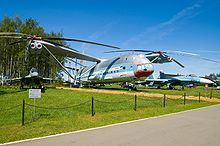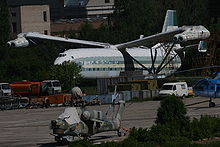Mil V-12 Video - Overview
|
|
Mil V-12
Mi-12 (V-12)
Picture - Mil V-12
Role: Heavy lift helicopter
Manufacturer: Mil Design Bureau
First flight: 10 July 1968
Status: Prototype only
Primary user: Soviet Union
Number built: 2
Developed from: Mil Mi-6
The Mil V-12 (also referred to as the Mi-12, NATO reporting name "Homer") is the largest helicopter ever built. The name "Mi-12" would have been the name for the production helicopter. Since the V-12 never went into production and only two prototypes were built, the name "Mi-12" was never adopted.
Design and development
Development came about as a need for a heavy lift helicopter capable of carrying major missile components. Production began on the V-12 prototype in 1965 with the goal of lifting no less than 30,000 kg.
The first prototype made its first lift-off on 27 June 1967. After a few oscillations in close proximity to the ground the V-12 made a rough touchdown on one wheel resulting in a burst tire and a bent wheel disk. Even though the damage was insignificant, it was reported in the Western press that the prototype had suffered severe damage, and even to this day the rumor persists that the prototype had crashed fatally.
The V-12 features the only two-rotor transverse scheme ever built by Mil, eliminating the need for a tail rotor. The twin engines were taken together with the rotors from the Mil Mi-6 and duplicated on the V-12. Being the first time used by Mil, the twin rotor transverse scheme was not new. It was first seen in the Focke-Wulf Fw 61 the first fully controlable helicopter from 1936. Later, other helicopters used the scheme such as the Focke Achgelis Fa 223 Drache from 1940. The Soviet Kamov OKB built an experimental aircraft with the same scheme in 1958, Kamov Ka-22 Vintokryl. This aircraft had also the combined wing/rotor arrangement later used on the Mil V-12.

Picture -
The first prototype, now wearing the registration SSSR-21142, made its first flight on 10 July 1968, flying from the Mil factory pad in Panki to the Mil OKB test flight facility in Lyubertsy. In February 1969, the first prototype lifted a 31,030 kg payload to 2,951m (9,682 feet). On 6 August 1969, the V-12 lifted 44,205 kg (88,636 lb) to a height of 2,255m (7,398 feet), a world record.
In May-June 1971 the first prototype V-12 SSSR-21142 made a series of flights over Europe being topped by the participation in the 29th Paris Air Show at Le Bourget wearing exhibit code H-833.
The second prototype had been assembled at the Mil experimental production facility in Panki but sat in the workshop for a full year waiting for its engines. It was not until March 1973 that the second prototype could make its first flight, being from Panki to the flight test facilities in Lyubertsy. Curiously the second prototype was also registered SSSR-21142.
The design outperformed its design specifications, set up numerous world records which still hold today, and brought its designers numerous awards such as the prestigious Sikorsky Prize awarded by the American Helicopter Society for outstanding achievements in helicopter technology. The V-12 design was recognized as an invention for which patents were issued in the USA, Great Britain and other countries.
Despite all of these achievements the Soviet Air Force refused to accept the helicopter for state acceptance trials for many reasons, the main one being the fact that the initial purpose for which V-12 had been developed no longer existed, i.e., the rapid deployment of strategic ballistic missiles. In the meantime the military concept of deploying missiles had been altered since some of the missiles had proved disappointing and were phased out. This was the same reason which led to the massive reduction in Antonov An-22 production. Another was that the design was expensive and that other lifting requirements were met with the Mi-6 and later by the more powerful Mil Mi-26.

Picture - Mi-12 at the Mil Helicopter Plant in Panki. Note the rotor blades removed.
All development on the V-12 was stopped in 1974. The first prototype remained at the Mikhail Leontyevich Mil helicopter plant in Panki-Tomilino, Lyuberetsky District near Moscow and is still there today (55°40′2″N 37°55′56″E / 55.66722°N 37.93222°E / 55.66722; 37.93222). The second prototype was donated to Monino Air Force Museum (50 km east of Moscow) and is on public display.
Operators
Soviet Union
Soviet Air Force commissioned the project but cancelled it before going into production.
Specifications (V-12)
Picture - Side view illustration
Data from Jane's All The World's Aircraft 1975-76
General characteristics
Crew: 6 (pilot, copilot, flight engineer, electrician, navigator, radio operator)
Capacity:
VTOL 25,000 kg (55,000 lb) or
STOL 30,000 kg (66,000 lb) or
40,204.5 kg (88,636 lb) record
Length: 37.00 m (121 ft 4 in)
Rotor diameter: 2x 35.00 m (114 ft 10 in)
Height: 12.50 m (41 ft 0 in)
Loaded weight: 97,000 kg (213,850 lb)
Max takeoff weight: 105,000 kg (231,500 lb)
Powerplant: 4x— Soloviev D-25VF turboshaft, 4,048 kW (6,500 shp) each
Freight compartment: 28.15x4.40x4.40 m (92 4x14 5x14 5 ft)
Performance
Maximum speed: 260 km/h (140 kt)
Range: 500 km (310 miles)
Service ceiling: 3,500 m (11,500 ft)
Related development
Mil Mi-6
Comparable aircraft
Mil Mi-26
Yakovlev Yak-60
Gordon, Yefim; Dimitriy and Sergey Komissarov (2005). Mil's heavylift helicopters : Mi-6, Mi-10, V-12 and Mi-26. Red Star. 22 (2nd edition ed.). Hinckley: Midland Publishing. ISBN 1-85780-206-3.
Living Warbirds: The best warbirds DVD series.
Source: WikiPedia